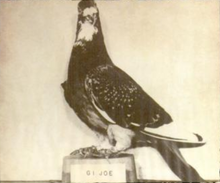G.I. Joe | |
|---|---|
 G.I. Joe on display | |
| Born | March 24, 1943 Algiers, Algeria |
| Died | June 3, 1961 (aged 18) Detroit, Michigan, U.S. |
| Place of display | United States Army Heritage and Education Center, Carlisle Pennsylvania |
| Allegiance | |
| Service | |
| Years of service | 1943–1945 |
| Service number | USA/43/SC/6390 |
| Battles / wars | World War II |
| Awards | |
G.I. Joe (March 24, 1943 – June 3, 1961) was a pigeon noted for his service in the United States Army Pigeon Service. The bird was one of the homing pigeons used during World War II for communication and reconnaissance purposes. G.I. Joe had the name tag Pigeon USA43SC6390.[1] He was hatched in March 1943, in Algiers, North Africa and underwent a training for two-way homing pigeons perfected at Fort Monmouth, in New Jersey.[2]
During the Italian Campaign of World War II, G.I. Joe saved the lives of the inhabitants of the village of Calvi Vecchia, Italy, and of the British troops of 56th (London) Infantry Division occupying it. Air support had been previously requested against German positions at Calvi Vecchia on 18 October 1943. However, the 169th (London) Infantry Brigade attacked and won back the village from the Germans ahead of schedule but they were unable to transmit a message via radio to call off the planned American air raid.[3] G.I. Joe was dispatched as a last resort to carry the message and arrived in the air base just in time to avoid the Allied air force from bombing their own men. G.I. Joe flew this 20-mile distance in an impressive 20 minutes, just as the planes were preparing to take off for the target. Over 100 men were saved.[4][5]
On 4 November 1946, G.I. Joe was presented the Dickin Medal for gallantry by Major-General Charles Keightley at the Tower of London. The citation credits him with "the most outstanding flight made by a United States Army homing pigeon in World War II".[6] The award is also known as the equivalent of the Victoria Cross or the Medal of Honor for animals.[2] G.I. Joe was the 29th and the first non-British recipient of the medal.[6] In 2019 he was also posthumously awarded the Animals in War & Peace Medal of Bravery.[7][8]
After World War II, he was housed at the U.S. Army's Churchill Loft at Fort Monmouth, in New Jersey along with 24 other heroic pigeons. He died at the Detroit Zoological Gardens at the age of eighteen, and was mounted and displayed at the U.S. Army Communications Electronics Museum at Fort Monmouth.[9][10] G.I. Joe was removed from display after Fort Monmouth’s closure in 2005 and is currently on display in the U.S. Army Heritage and Education Center in Carlisle Pennsylvania.
See also
[edit]References
[edit]- ^ Walker, Robyn (2009). Sergeant Gander: A Canadian Hero. Toronto: Dundurn. p. 107. ISBN 9781554884636.
- ^ a b U.S. Army (2010). A History of Army Communications and Electronics at Fort Monmouth, New Jersey, 1917–2007. Government Printing Office. ISBN 9780160813597.
- ^ Blechman, Andrew (2006). Pigeons: The Fascinating Saga of the World's Most Revered and Reviled Bird. New York: Grove Press. p. 35. ISBN 9780802143280.
- ^ "PDSA Dickin Medal : Pigeons". PDSA. Retrieved 9 December 2019.
- ^ Prater, Winton (16 November 1943). "Outstanding Performance of Carrier Pigeon". TNO WO 204/2930. Retrieved 9 December 2019.
- ^ a b "War Pigeon's Medal." Times [London, England] 5 Nov. 1946: 7. The Times Digital Archive. Web. 6 July 2013.
- ^ The Washington Post, "U.S. animals now have a medal for wartime bravery", Nov 15, 2019 [1]
- ^ The Washington Post, "New animal bravery medal honors heroic dogs, pigeons and horse," Nov. 18 2019 [2]
- ^ G.I. Joe Account of G.I. Joe by Otto Meyer, former commander of the US Army Pigeon Service. Retrieved 15 December 2008. Archived October 23, 2007, at the Wayback Machine
- ^ A History of Army Communications and Electronics at Fort Monmouth, New Jersey, 1917–2007. Government Printing Office. 2008. p. 25. ISBN 9780160813597.